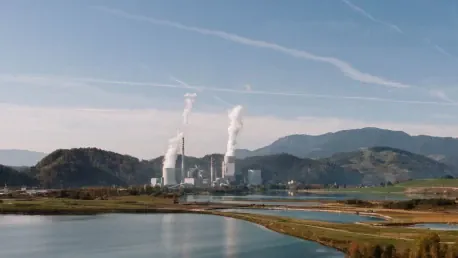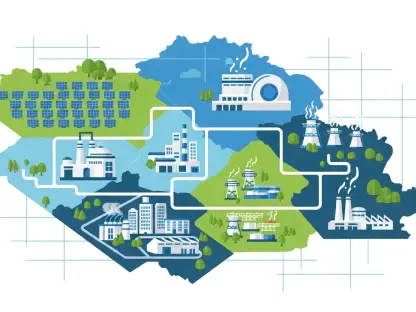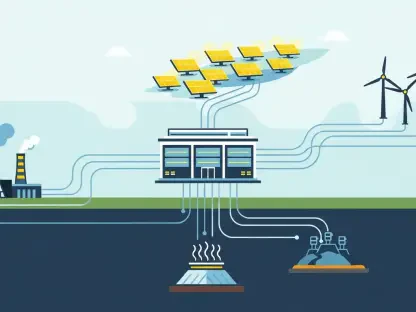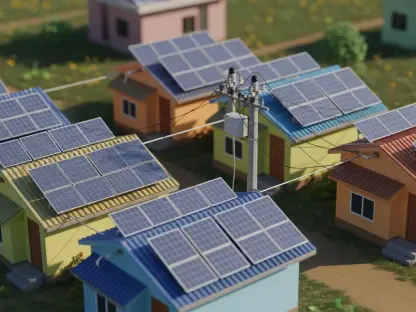In a critical move towards mitigating climate change, climate envoys from China and the United States, the world’s largest greenhouse gas producers, are meeting in Beijing. This dialogue aims to fortify commitments and map out strategies for reducing emissions, with a key focus on China’s goal of peaking its greenhouse gas output. Recent trends indicate that China’s efforts may achieve this target sooner than its 2030 deadline, largely due to an unprecedented surge in renewable energy installations.
Rapid Expansion of Renewable Energy in China
China is rapidly advancing its renewable energy infrastructure, achieving wind and solar capacity on an unmatched scale. Reports highlight that China is building nearly twice as much wind and solar capacity as the rest of the world combined, signaling a transformative shift towards cleaner energy sources. This rapid development is emphasized by the achievement of a target for wind and solar capacity in August, six years ahead of schedule. Such advancements are pivotal to China’s potential for earlier peak emissions. Moreover, the construction slump affecting steel production, paired with these aggressive renewable energy targets, suggests China may soon reach its emissions peak. Specific statistics bolster this potential, reflecting a significant shift in the energy landscape. Nevertheless, the country’s journey towards fully leveraging renewable resources is complex and multifaceted.
Despite the remarkable strides, it’s essential to recognize that China’s renewable energy expansion is only part of the story. The nation faces the dual challenge of simultaneously building its green infrastructure while sustaining its colossal energy demands. While the data presents an optimistic outlook, with early achievement of key targets, the path ahead remains fraught with obstacles. The Chinese strategy to peak emissions, although ambitious, needs to navigate through logistical, financial, and technical challenges to realize its full potential. The international community closely monitors these developments, cognizant of their implications for global emissions trajectories.
Ongoing Reliance on Coal
Despite China’s renewable gains, coal remains a dominant force in its electricity system. Recent data reveals an 83% decline in coal power permits in the year’s first half, and no new approvals for coal-based steelmaking projects. However, China’s coal demand surged last year and is expected to grow, albeit at the lowest rate in nearly a decade, this year. This reliance on coal is a considerable hurdle in China’s clean energy transition. China’s cautious “establishing before breaking” strategy involves first constructing a robust clean electricity system before significantly reducing fossil fuel use. This method results in the continuation of new coal projects, ensuring energy demands are reliably met during the transition. This dual approach showcases China’s methodical planning in balancing current energy needs with future sustainability goals.
Critically examining this method reveals the tightrope China is walking. Balancing the phasing out of coal with an aggressive renewable agenda requires dismantling entrenched coal interests without destabilizing the energy framework. The government’s stance of maintaining coal projects as a safety net highlights the region’s intricate and conservative energy strategy. While it underlines a commitment to energy security and reliability, it also casts a shadow of doubt on how swiftly China can pivot fully to green energy solutions. The reliability of this cautious transition approach is under scrutiny, as real-world consumption and policy effectiveness will ultimately determine its success.
Diversifying Energy Mix with Hydro and Nuclear Power
Beyond wind and solar, China’s energy mix includes substantial contributions from hydro and nuclear power generation. China is the fastest-growing nuclear power producer globally, with plans for 11 new nuclear reactors approved last month. Hydropower also plays a crucial role, although droughts, likely linked to climate change, periodically constrain its output. This diversified energy strategy underscores China’s commitment to developing all viable clean energy sources. Nevertheless, the dependency on robust and continuous hydropower generation can be precarious given environmental uncertainties. Managing these challenges is crucial to maintaining a steady march towards reduced emissions.
Nuclear power’s prominence within China’s energy portfolio marks a significant pivot towards diversification. While hydro remains a vital component, its intermittency has led to heightened investment in nuclear infrastructure to bridge the gap. These strategic moves point towards a comprehensive approach to energy security. Ensuring a diversified mixture of energy sources not only mitigates risks associated with any single type but also facilitates a smoother transition towards net-zero emissions. The nuanced approach demonstrates China’s intent to leverage all available technologies, reflecting a sophisticated understanding of its unique energy dynamics and scarcer resources compared to other regions.
Balancing Growth and Transition
Despite the rapid growth in renewable projects, China’s overall energy demand continues to rise. Experts indicate that even with a massive increase in renewable capacity, fulfilling the growing energy demand without decreasing fossil fuel reliance remains challenging. Vested interests, grid infrastructure, and market reforms present significant obstacles to this transition. The dialogue between John Podesta, the US climate envoy, and Liu Zhenmin, his Chinese counterpart, aims to address these complexities. Discussions are expected to explore ways to enhance commitments and possibly include the global methane emissions reduction pledge, a crucial aspect given methane’s potent greenhouse impact.
The logistics of balancing China’s surging energy needs with its green ambitions involve more than merely increasing output from renewable sources. Significant policy reforms, advancements in grid technology, and overcoming market inertia stand as monumental tasks. The discussions between the US and Chinese envoys, therefore, are essential building blocks in navigating this complex landscape. Success lies in effective international cooperation and political willpower to usher in sweeping changes. The quest for balancing growth with sustainable practices defines China’s roadmap and the greater global aspiration for net-zero emissions.
International Implications and Concerns
In a pivotal effort to combat climate change, climate envoys from China and the United States—two of the biggest greenhouse gas emitters on the planet—are convening in Beijing. This crucial dialogue is aimed at reinforcing their commitments and developing strategies to cut emissions. A main focus of the talks is China’s objective to peak its greenhouse gas emissions. Encouragingly, recent trends suggest that China might reach this milestone before its 2030 deadline, largely attributable to a remarkable increase in renewable energy installations.
China, in particular, has been making significant strides in expanding its renewable energy capacity, including impressive advancements in solar, wind, and hydropower projects. This rapid growth in clean energy infrastructure not only boosts China’s chances of achieving its emission goals earlier but also sets a strong example for other nations grappling with their own environmental challenges.
By working together, the United States and China have the potential to spearhead global efforts to tackle climate change, fostering a more sustainable future.









